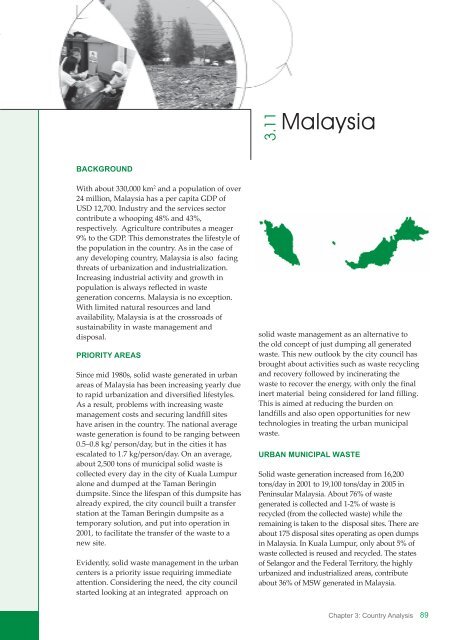A Gap Analysis in Selected Asian Countries, 3R Knowledge Hub ...
A Gap Analysis in Selected Asian Countries, 3R Knowledge Hub ...
A Gap Analysis in Selected Asian Countries, 3R Knowledge Hub ...
Create successful ePaper yourself
Turn your PDF publications into a flip-book with our unique Google optimized e-Paper software.
BACKGROUND<br />
With about 330,000 km 2 and a population of over<br />
24 million, Malaysia has a per capita GDP of<br />
USD 12,700. Industry and the services sector<br />
contribute a whoop<strong>in</strong>g 48% and 43%,<br />
respectively. Agriculture contributes a meager<br />
9% to the GDP. This demonstrates the lifestyle of<br />
the population <strong>in</strong> the country. As <strong>in</strong> the case of<br />
any develop<strong>in</strong>g country, Malaysia is also fac<strong>in</strong>g<br />
threats of urbanization and <strong>in</strong>dustrialization.<br />
Increas<strong>in</strong>g <strong>in</strong>dustrial activity and growth <strong>in</strong><br />
population is always reflected <strong>in</strong> waste<br />
generation concerns. Malaysia is no exception.<br />
With limited natural resources and land<br />
availability, Malaysia is at the crossroads of<br />
susta<strong>in</strong>ability <strong>in</strong> waste management and<br />
disposal.<br />
PRIORITY AREAS<br />
S<strong>in</strong>ce mid 1980s, solid waste generated <strong>in</strong> urban<br />
areas of Malaysia has been <strong>in</strong>creas<strong>in</strong>g yearly due<br />
to rapid urbanization and diversified lifestyles.<br />
As a result, problems with <strong>in</strong>creas<strong>in</strong>g waste<br />
management costs and secur<strong>in</strong>g landfill sites<br />
have arisen <strong>in</strong> the country. The national average<br />
waste generation is found to be rang<strong>in</strong>g between<br />
0.5–0.8 kg/ person/day, but <strong>in</strong> the cities it has<br />
escalated to 1.7 kg/person/day. On an average,<br />
about 2,500 tons of municipal solid waste is<br />
collected every day <strong>in</strong> the city of Kuala Lumpur<br />
alone and dumped at the Taman Ber<strong>in</strong>g<strong>in</strong><br />
dumpsite. S<strong>in</strong>ce the lifespan of this dumpsite has<br />
already expired, the city council built a transfer<br />
station at the Taman Ber<strong>in</strong>g<strong>in</strong> dumpsite as a<br />
temporary solution, and put <strong>in</strong>to operation <strong>in</strong><br />
2001, to facilitate the transfer of the waste to a<br />
new site.<br />
Evidently, solid waste management <strong>in</strong> the urban<br />
centers is a priority issue requir<strong>in</strong>g immediate<br />
attention. Consider<strong>in</strong>g the need, the city council<br />
started look<strong>in</strong>g at an <strong>in</strong>tegrated approach on<br />
3.11<br />
Malaysia<br />
solid waste management as an alternative to<br />
the old concept of just dump<strong>in</strong>g all generated<br />
waste. This new outlook by the city council has<br />
brought about activities such as waste recycl<strong>in</strong>g<br />
and recovery followed by <strong>in</strong>c<strong>in</strong>erat<strong>in</strong>g the<br />
waste to recover the energy, with only the f<strong>in</strong>al<br />
<strong>in</strong>ert material be<strong>in</strong>g considered for land fill<strong>in</strong>g.<br />
This is aimed at reduc<strong>in</strong>g the burden on<br />
landfills and also open opportunities for new<br />
technologies <strong>in</strong> treat<strong>in</strong>g the urban municipal<br />
waste.<br />
URBAN MUNICIPAL WASTE<br />
Solid waste generation <strong>in</strong>creased from 16,200<br />
tons/day <strong>in</strong> 2001 to 19,100 tons/day <strong>in</strong> 2005 <strong>in</strong><br />
Pen<strong>in</strong>sular Malaysia. About 76% of waste<br />
generated is collected and 1-2% of waste is<br />
recycled (from the collected waste) while the<br />
rema<strong>in</strong><strong>in</strong>g is taken to the disposal sites. There are<br />
about 175 disposal sites operat<strong>in</strong>g as open dumps<br />
<strong>in</strong> Malaysia. In Kuala Lumpur, only about 5% of<br />
waste collected is reused and recycled. The states<br />
of Selangor and the Federal Territory, the highly<br />
urbanized and <strong>in</strong>dustrialized areas, contribute<br />
about 36% of MSW generated <strong>in</strong> Malaysia.<br />
Chapter 3: Country <strong>Analysis</strong><br />
89
















